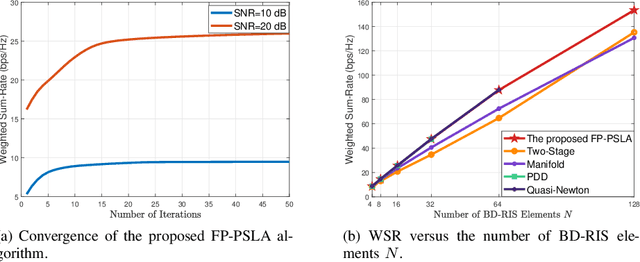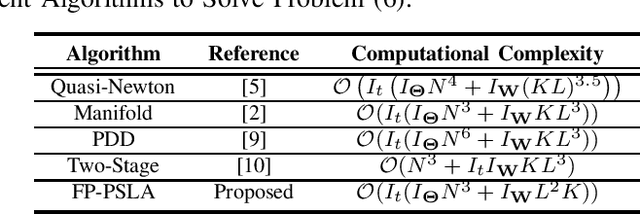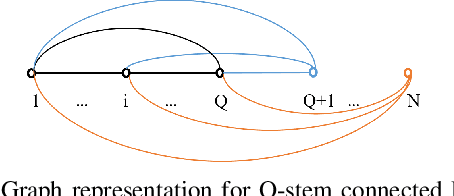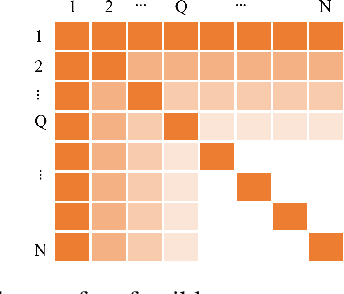Yijie Mao
RIS-Assisted Passive Localization (RAPL): An Efficient Zero-Overhead Framework Using Conditional Sample Mean
Mar 25, 2025Abstract:Reconfigurable Intelligent Surface (RIS) has been recognized as a promising solution for enhancing localization accuracy. Traditional RIS-based localization methods typically rely on prior channel knowledge, beam scanning, and pilot-based assistance. These approaches often result in substantial energy and computational overhead, and require real-time coordination between the base station (BS) and the RIS. To address these challenges, in this work, we move beyond conventional methods and introduce a novel data-driven, multiple RISs-assisted passive localization approach (RAPL). The proposed method includes two stages, the angle-of-directions (AoDs) between the RISs and the user is estimated by using the conditional sample mean in the first stage, and then the user's position is determined based on the estimated multiple AoD pairs in the second stage. This approach only utilizes the existing communication signals between the user and the BS, relying solely on the measurement of received signal power at each BS antenna for a set of randomly generated phase shifts across all RISs. Moreover, by obviating the need for real-time RIS phase shift optimization or user-to-BS pilot transmissions, the method introduces no additional communication overhead, making it highly suitable for deployment in real-world networks. The proposed scheme is then extended to multi-RIS scenarios considering both parallel and cascaded RIS topologies. Numerical results show that the proposed RAPL improves localization accuracy while significantly reducing energy and signaling overhead compared to conventional methods.
RIS-Assisted Localization: A Novel Conditional Sample Mean Approach without CSI
Mar 24, 2025


Abstract:Reconfigurable intelligent surface (RIS) has been recognized as a promising solution for enhancing localization accuracy. Traditional RIS-based localization methods typically rely on prior channel knowledge, beam scanning, and pilot-based assistance. These approaches often result in substantial energy and computational overhead, and require real-time coordination between the base station (BS) and the RIS. In this work, we propose a novel multiple RISs aided localization approach to address these challenges. The proposed method first estimates the angle-of-directions (AoDs) between the RISs and the user using the conditional sample mean approach, and then uses the estimated multiple AoD pairs to determine the user's position. This approach only requires measuring the received signal strength at the BS for a set of randomly generated phase shifts across all RISs, thereby eliminating the need for real-time RIS phase shift design or user-to-BS pilot transmissions. Numerical results show that the proposed localization approach improves localization accuracy while significantly reducing energy and signaling overhead compared to conventional methods.
Joint Active and Passive Beamforming Optimization for Beyond Diagonal RIS-aided Multi-User Communications
Jan 17, 2025

Abstract:Benefiting from its capability to generalize existing reconfigurable intelligent surface (RIS) architectures and provide additional design flexibility via interactions between RIS elements, beyond-diagonal RIS (BD-RIS) has attracted considerable research interests recently. However, due to the symmetric and unitary passive beamforming constraint imposed on BD-RIS, existing joint active and passive beamforming optimization algorithms for BD-RIS either exhibit high computational complexity to achieve near optimal solutions or rely on heuristic algorithms with substantial performance loss. In this paper, we address this issue by proposing an efficient optimization framework for BD-RIS assisted multi-user multi-antenna communication networks. Specifically, we solve the weighted sum rate maximization problem by introducing a novel beamforming optimization algorithm that alternately optimizes active and passive beamforming matrices using iterative closed-form solutions. Numerical results demonstrate that our algorithm significantly reduces computational complexity while ensuring a sub-optimal solution.
RIS-aided Wireless-Powered Backscatter Communications for Sustainable Internet of Underground Things
Dec 10, 2024



Abstract:Wireless-powered underground sensor networks (WPUSNs), which enable wireless energy transfer to sensors located underground, is a promising approach for establishing sustainable internet of underground things (IoUT). To support urgent information transmission and improve resource utilization within WPUSNs, backscatter communication (BC) is introduced, resulting in what is known as wireless-powered backscatter underground sensor networks (WPBUSNs). Nevertheless, the performance of WPBUSNs is significantly limited by severe channel impairments caused by the underground soil and the blockage of direct links. To overcome this challenge, in this work, we propose integrating reconfigurable intelligent surface (RIS) with WPBUSNs, leading to the development of RIS-aided WPBUSNs. We begin by reviewing the recent advancements in BC-WPUSNs and RIS. Then, we propose a general architecture of RIS-aided WPBUSNs across various IoUT scenarios, and discuss its advantages and implementation challenges. To illustrate the effectiveness of RIS-aided WPBUSNs, we focus on a realistic farming case study, demonstrating that our proposed framework outperforms the three benchmarks in terms of the sum throughput. Finally, we discuss the open challenges and future research directions for translating this study into practical IoUT applications.
Joint Beam Scheduling and Resource Allocation for Flexible RSMA-aided Near-Field Communications
Nov 30, 2024

Abstract:Supporting immense throughput and ubiquitous connectivity holds paramount importance for future wireless networks. To this end, this letter focuses on how the spatial beams configured for legacy near-field (NF) users can be leveraged to serve extra NF or far-field users while ensuring the rate requirements of legacy NF users. In particular, a flexible rate splitting multiple access (RSMA) scheme is proposed to efficiently manage interference, which carefully selects a subset of legacy users to decode the common stream. Beam scheduling, power allocation, common rate allocation, and user selection are jointly optimized to maximize the sum rate of additional users. To solve the formulated discrete non-convex problem, it is split into three subproblems. The accelerated bisection searching, quadratic transform, and simulated annealing approaches are developed to attack them. Simulation results reveal that the proposed transmit scheme and algorithm achieve significant gains over three competing benchmarks.
A Novel Q-stem Connected Architecture for Beyond-Diagonal Reconfigurable Intelligent Surfaces
Nov 27, 2024



Abstract:Beyond-diagonal reconfigurable intelligent surface (BD-RIS) has garnered significant research interest recently due to its ability to generalize existing reconfigurable intelligent surface (RIS) architectures and provide enhanced performance through flexible inter-connection among RIS elements. However, current BD-RIS designs often face challenges related to high circuit complexity and computational complexity, and there is limited study on the trade-off between system performance and circuit complexity. To address these issues, in this work, we propose a novel BD-RIS architecture named Q-stem connected RIS that integrates the characteristics of existing single connected, tree connected, and fully connected BD-RIS, facilitating an effective trade-off between system performance and circuit complexity. Additionally, we propose two algorithms to design the RIS scattering matrix for a Q-stem connected RIS aided multi-user broadcast channels, namely, a low-complexity least squares (LS) algorithm and a suboptimal LS-based quasi-Newton algorithm. Simulations show that the proposed architecture is capable of attaining the sum channel gain achieved by fully connected RIS while reducing the circuit complexity. Moreover, the proposed LS-based quasi-Newton algorithm significantly outperforms the baselines, while the LS algorithm provides comparable performance with a substantial reduction in computational complexity.
Robust Max-Min Fair Beamforming Design for Rate Splitting Multiple Access-aided Visible Light Communications
Nov 26, 2024Abstract:This paper addresses the robust beamforming design for rate splitting multiple access (RSMA)-aided visible light communication (VLC) networks with imperfect channel state information at the transmitter (CSIT). In particular, we first derive the theoretical lower bound for the channel capacity of RSMA-aided VLC networks.Then we investigate the beamforming design to solve the max-min fairness (MMF) problem of RSMA-aided VLC networks under the practical optical power constraint and electrical power constraint while considering the practical imperfect CSIT scenario.To address the problem, we propose a constrained-concave-convex programming (CCCP)-based beamforming design algorithm which exploits semidefinite relaxation (SDR) technique and a penalty method to deal with the rank-one constraint caused by SDR.Numerical results show that the proposed robust beamforming design algorithm for RSMA-aided VLC network achieves a superior performance over the existing ones for space-division multiple access (SDMA) and non-orthogonal multiple access (NOMA).
RS-BNN: A Deep Learning Framework for the Optimal Beamforming Design of Rate-Splitting Multiple Access
Jul 09, 2024



Abstract:Rate splitting multiple access (RSMA) relies on beamforming design for attaining spectral efficiency and energy efficiency gains over traditional multiple access schemes. While conventional optimization approaches such as weighted minimum mean square error (WMMSE) achieve suboptimal solutions for RSMA beamforming optimization, they are computationally demanding. A novel approach based on fractional programming (FP) has unveiled the optimal beamforming structure (OBS) for RSMA. This method, combined with a hyperplane fixed point iteration (HFPI) approach, named FP-HFPI, provides suboptimal beamforming solutions with identical sum rate performance but much lower computational complexity compared to WMMSE. Inspired by such an approach, in this work, a novel deep unfolding framework based on FP-HFPI, named rate-splitting-beamforming neural network (RS-BNN), is proposed to unfold the FP-HFPI algorithm. Numerical results indicate that the proposed RS-BNN attains a level of performance closely matching that of WMMSE and FP-HFPI, while dramatically reducing the computational complexity.
Transmitter Side Beyond-Diagonal RIS for mmWave Integrated Sensing and Communications
Apr 19, 2024



Abstract:This work initiates the study of a beyond-diagonal reconfigurable intelligent surface (BD-RIS)-aided transmitter architecture for integrated sensing and communication (ISAC) in the millimeter-wave (mmWave) frequency band. Deploying BD-RIS at the transmitter side not only alleviates the need for extensive fully digital radio frequency (RF) chains but also enhances both communication and sensing performance. These benefits are facilitated by the additional design flexibility introduced by the fully-connected scattering matrix of BD-RIS. To achieve the aforementioned benefits, in this work, we propose an efficient two-stage algorithm to design the digital beamforming of the transmitter and the scattering matrix of the BD-RIS with the aim of jointly maximizing the sum rate for multiple communication users and minimizing the largest eigenvalue of the Cramer-Rao bound (CRB) matrix for multiple sensing targets. Numerical results show that the transmitter-side BD-RIS-aided mmWave ISAC outperforms the conventional diagonal-RIS-aided ones in both communication and sensing performance.
Distributed Multi-Objective Dynamic Offloading Scheduling for Air-Ground Cooperative MEC
Mar 16, 2024



Abstract:Utilizing unmanned aerial vehicles (UAVs) with edge server to assist terrestrial mobile edge computing (MEC) has attracted tremendous attention. Nevertheless, state-of-the-art schemes based on deterministic optimizations or single-objective reinforcement learning (RL) cannot reduce the backlog of task bits and simultaneously improve energy efficiency in highly dynamic network environments, where the design problem amounts to a sequential decision-making problem. In order to address the aforementioned problems, as well as the curses of dimensionality introduced by the growing number of terrestrial terrestrial users, this paper proposes a distributed multi-objective (MO) dynamic trajectory planning and offloading scheduling scheme, integrated with MORL and the kernel method. The design of n-step return is also applied to average fluctuations in the backlog. Numerical results reveal that the n-step return can benefit the proposed kernel-based approach, achieving significant improvement in the long-term average backlog performance, compared to the conventional 1-step return design. Due to such design and the kernel-based neural network, to which decision-making features can be continuously added, the kernel-based approach can outperform the approach based on fully-connected deep neural network, yielding improvement in energy consumption and the backlog performance, as well as a significant reduction in decision-making and online learning time.
 Add to Chrome
Add to Chrome Add to Firefox
Add to Firefox Add to Edge
Add to Edge